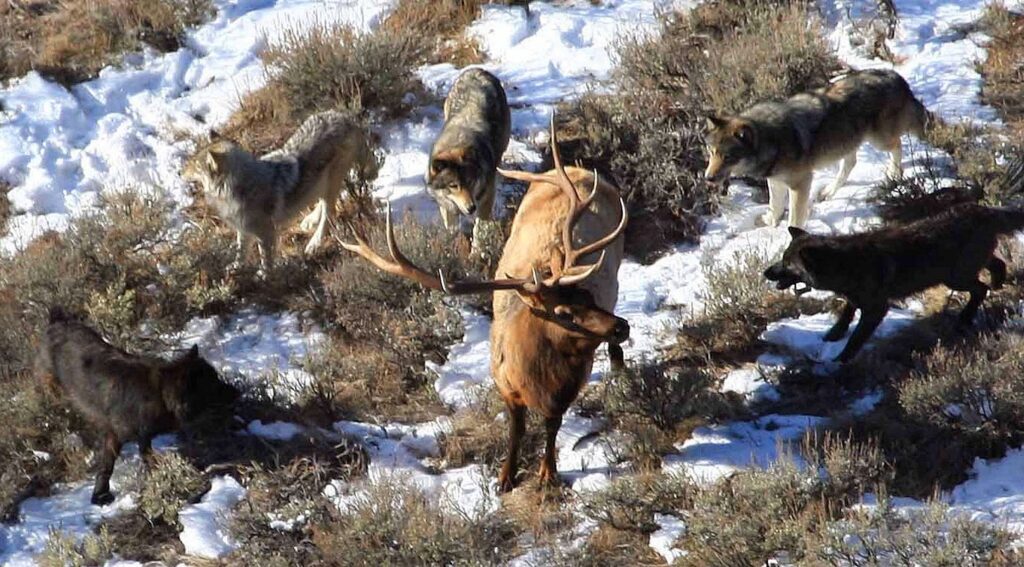Trump Administration Returns Management and Protection of Gray Wolves to States and Tribes Following Successful Recovery Efforts
DEPARTMENT OF THE INTERIOR PRESS RELEASE
BLOOMINGTON, Minn. – More than 45 years after gray wolves were first listed under the Endangered Species Act (ESA), the Trump Administration and its many conservation partners are announcing the successful recovery of the gray wolf and its delisting from the ESA. U.S. Secretary of the Interior David L. Bernhardt was at the Minnesota Valley National Wildlife Refuge to announce that state and tribal wildlife management agency professionals will resume responsibility for sustainable management and protection of delisted gray wolves in states with gray wolf populations, while the U.S. Fish and Wildlife Service (Service) monitors the species for five years to ensure the continued success of the species.
The Service based its final determination solely on the best scientific and commercial data available, a thorough analysis of threats and how they have been alleviated and the ongoing commitment and proven track record of states and tribes to continue managing for healthy wolf populations once delisted. This analysis includes the latest information about the wolf’s current and historical distribution in the contiguous United States
“Today’s action reflects the Trump Administration’s continued commitment to species conservation based on the parameters of the law and the best scientific and commercial data available,” said Secretary Bernhardt. “After more than 45 years as a listed species, the gray wolf has exceeded all conservation goals for recovery. Today’s announcement simply reflects the determination that this species is neither a threatened nor endangered species based on the specific factors Congress has laid out in the law.”
In total, the gray wolf population in the lower 48 states is more than 6,000 wolves, greatly exceeding the combined recovery goals for the Northern Rocky Mountains and Western Great Lakes populations.
The gray wolf is the latest in a strong list of ESA recoveries that includes the bald eagle, peregrine falcon, American alligator, brown pelican and 48 other species of animals and plants in U.S. states, territories and waters. Countless more have improved or stabilized. Collectively, these successes demonstrate that the ESA can make a difference for imperiled species.
No administration in history has recovered more imperiled species in their first term than the Trump Administration. Since 2017, thirteen species – and now the gray wolf – have been determined to not be either a threatened species or endangered species under the ESA’s List of Endangered and Threatened Wildlife, and another seven species have been downlisted from endangered species to threatened species. To provide context for this in looking at other administrations in their first term, the Obama Administration recovered six species; the Bush Administration recovered eight species; and the Clinton Administration recovered nine species.
“President Trump’s Administration has focused on proactive measures, including partnerships with organizations, to ensure listed species flourish to the point of recovery,” said Director of the U.S. Fish and Wildlife Service Aurelia Skipwith. “Today is a win for the gray wolf and the American people. I am grateful for these partnerships with States and Tribes and their commitment to sustainable management of wolves that will ensure the species long-term survival following this delisting.”
By the early part of the 20th century, the gray wolf had become scarce across almost the entire landscape of the lower 48 states. But, the dedicated efforts of partners that included states, tribes, conservation organizations and private landowners working together under the auspices of the ESA, brought this great predator back to healthy, stable numbers. Gray wolves in the United States exist primarily as two large, genetically diverse, stable to growing populations broadly distributed across several contiguous U.S. States, with an additional large population in Alaska that was never listed.
Gray wolves in the Northern Rocky Mountains, where a healthy and sustainable population roams across Wyoming, Montana, Idaho, and eastern portions of Oregon and Washington, were previously delisted. These states have since managed this delisted population effectively and responsibly. Wolves have even expanded into western Oregon, western Washington, northern California and most recently in northwest Colorado.

The Western Great Lakes wolf population in Michigan, Wisconsin and Minnesota, the largest outside Alaska, is also strong and stable. These states have been key partners in wolf recovery efforts and have made a commitment to continue their activities. The states of Washington, Oregon, California and Colorado are also committed to conserving wolves, as demonstrated by their development of management plans and laws protecting wolves.
This final rule excludes Mexican wolves as that species remains listed under the ESA. The final rule will be effective 60 days after publication in the Federal Register.
More information is online at https://www.fws.gov/home/wolfrecovery.
BACKGROUND ON ESA REFORMS AND NORTH AMERICAN MODEL OF WILDLIFE CONSERVATION UNDER THE TRUMP ADMINISTRATION
Fish and wildlife conservation depends on federal partnerships with states, landowners, and most importantly sportsmen who directly fund – to the tune of $1 billion last year alone and more than $23 billion since inception – conservation efforts by purchasing hunting and fishing licenses, fishing tackle, ammunition, boating fuel and other recreational items.
To support stronger on-the-ground conservation efforts, encourage private actions to benefit our most imperiled species and provide greater legal certainty for ESA determinations, the Service updated its ESA regulations in 2019 to improve the implementation of the law. The regulations hadn’t been updated since the ESA passed some forty years ago. However, those changes did not modify the five statutory factors that are considered for each listing determination.
To see comments from Congressional leaders, please read the entire press release here.




Kill Every Wolf. And and everything else that deserves a wild dog coyote lion bear etc.